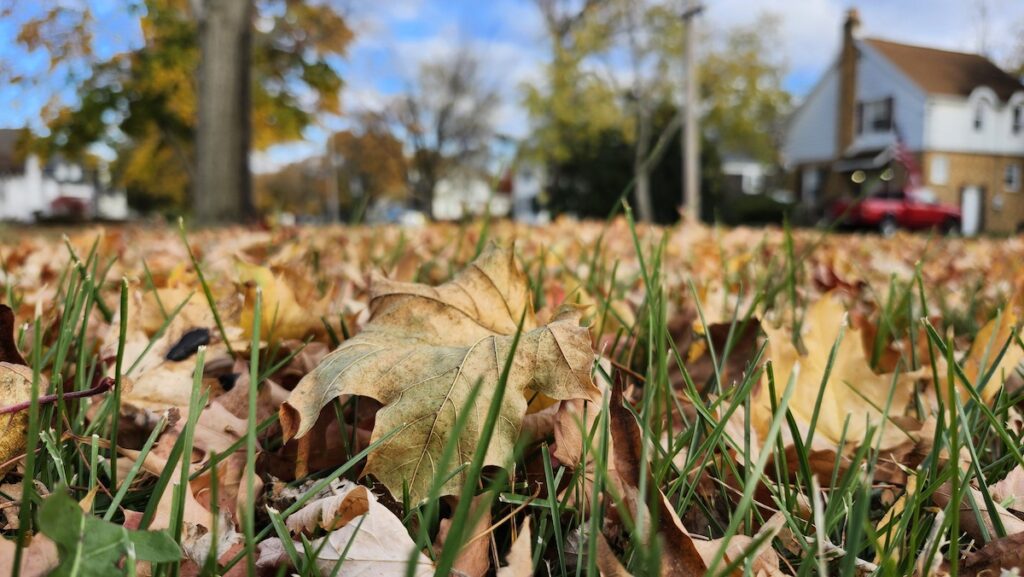
This November, consider yourself a wildlife gardener and see the leaves in a new light.
Every year, our deciduous trees undergo what is called leaf senescence. This is the process of aging in which plants degrade their chlorophyll (what gives leaves their green color), and nutrients are transported from the leaves to be stored by other plant organs over the winter. The green chlorophyll masks the other colors throughout the year. Without the chlorophyll, the leaves of maples appear scarlet, oaks appear russet, and hickories appear bronze. All throughout Michigan, it is a miraculous display of color we all can enjoy.
Imagine yourself on a stroll through the woods, listening to the whistling wind and watching as the leaves catch the sunlight falling gently to the earth. Maybe you catch the leaves for good luck, maybe you take some home to make leaf art, or maybe you simply enjoy the crisp air and the sound of crunching leaves beneath your feet. Remember the magic of nature’s gifts, and they’re not just for us.
In forests, prairies, and wetlands alike, a fresh layer of plant material settles to cover the ground every autumn, forming a rich layer of mulch. This natural mulch is important — it provides the winter homes for countless critters and creatures, from salamanders to box-turtles to fireflies. In fact, thousands of species of pollinator insects, including 94% of moth species, use the leaf litter during their life cycle. Many backyard birds, in turn, feed their babies with moth caterpillars in the spring. Leaves and twigs also decompose to recycle nutrients to the soil, and the seeds in acorns and berries are food for birds and mammals. The mulch also insulates the ground, keeping soil invertebrates warmer over the winter and retaining moisture in the soil.
If you’re a homeowner, you can have a positive impact by creating wildlife habitat this winter by preserving it instead of removing it. Instead of clearing all of the leaves off the lawn and treating them like a waste product, consider ways to keep some of the leaves on your property. Do you have a garden bed? Leaves will make great mulch by adding nutrients back into the soil and suppressing weeds. Covering any bare soil with leaf mulch will also prevent erosion of topsoil over the winter. Can you start a compost pile? Dry leaves and twigs contribute the brown source material (higher in carbon), while food scraps and grass clippings will contribute the green source material (higher in nitrogen), both of which are needed for a balanced compost pile. If there are trees in your yard, consider concentrating the leaf litter into donut piles surrounding the tree trunks. This will protect the tree roots and provide much better habitat than lawn grass that requires mowing.
In addition to rethinking where you can leave the leaves, also keep in mind how you may try to move them, if at all. Traditional gas-powered leaf blowers and lawn mowers emit a significant amount of air pollution. According to the EPA’s 2020 National Emissions Inventory, the lawn care industry in the U.S. released 68,000 tons of nitrous oxide and 30 million tons of carbon dioxide. Leaf blower gas-powered engines are extremely inefficient and generate awful noise pollution. Electric leaf blowers are a great alternative — they are quieter, don’t generate emissions, and will likely save you money in the long run. Their lithium-ion batteries are also interchangeable with other electric tools like lawn mowers, trimmers, chain saws, and snow blowers. Shredding leaves where they lay with a lawnmower is another alternative to removing them entirely. Leaf clippings will decompose quickly into the soil and provide free fertilizer for the grass. Maintaining some areas with whole leaves is still the best option for creating wildlife habitat and providing weed suppression.
To make things interesting, the conservation district polled all of the staff in the USDA service center, which includes employees of Farm Service Agency, Natural Resource Conservation Service, and the Lenawee Conservation District. We asked staff if they had trees and a yard, what did they do with their leaves in the fall? Of the 12 people surveyed, five mow the leaves into their yard; three relocate them into compost piles, mulch for garden beds, or neighboring wooded or pasture areas; and four decide to leave the leaves where they fall and do nothing with them. And while some might consider this last option lazy, you now have a great excuse for doing less with the leaves and benefiting the environment.
Whatever your yard size, you have an opportunity to steward the land by leaving the leaves this November. If you don’t have enough leaves and want more, you can visit the Adrian Compost Site to pick up large paper bags full of leaves from the Maple City. Leaves have so many benefits, from nature play, to nutritious compost, to wildlife habitat. If you would like to learn more about the Leave the Leaves campaign by Xerces Society for Invertebrate Conservation, you can visit xerces.org/leave-the-leaves. We hope you’ll appreciate the holistic value of the many leaves (nature’s gifts) that fall upon you.
Allegra Baird is a conservation specialist with the Lenawee Conservation District. She can be reached at [email protected] or 517-263-7400.

